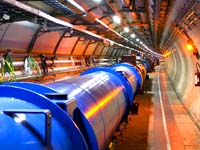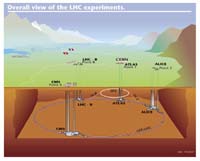

The Large Hadron Collider (LHC) is a proton-proton collider which is being built near Geneva, on the border between Switzerland and France.
Two beams of highly accelerated protons circulate in opposite directions
through the LHC, colliding in the centres of the detectors, ATLAS and CMS.
Each proton has a kinetic energy of 7 TeV, so the maximum
centre-of-mass energy of the collisions is 14 TeV.
The protons are not point-like; they are made up of valence quarks (two up-type
quarks and one down-type quark) held together by gluons and bathing in a "sea"
of virtual quark-anti-quark pairs.
These components of the protons (collectively called partons) can
annihilate in the collision and their kinetic energy can then be converted
back into mass.
The very high energies carried by the annihilated partons are then
converted into new, potentially very massive particles - this is an
illustration of Einstein's famous equation E=mc2.

LHC tunnel with magnets (CERN photo)
|

Artist's conception of LHC layout (CERN image)
|
Supposing that by chance all of the kinetic energy in one proton was carried by a single gluon, and all of the kinetic energy of a proton in the other beam was carried by a single gluon, and these two gluons collided and interacted to form a new particle. In that case, the new particle could have a mass of up to 14 TeV. It is very unlikely that so large a fraction of the colliding protons' energy will actually be carried by the main interacting particles, so typically less energy is available. The quantity of energy involved in the interaction is referred to as Q2. The LHC runs at very high luminosity, which means that there are very large numbers of protons in the beams, in order to accumulate statistics at high Q2. This increases the probability of observing the creation of new particles with masses of 1 TeV/c2 or more.
More information is available at the CERN LHC Outreach pages.